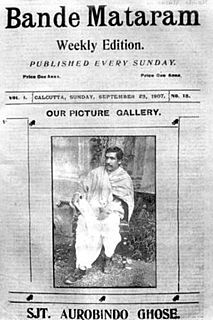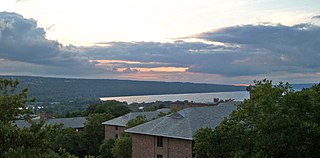
"The Maple Leaf Forever" is a Canadian song written by Alexander Muir (1830–1906) in 1867, the year of Canada's Confederation. He wrote the work after serving with the Queen's Own Rifles of Toronto in the Battle of Ridgeway against the Fenians in 1866.
"Land of Hope and Glory" is a British patriotic song, with music by Edward Elgar and lyrics by A. C. Benson, written in 1901.

"America " is an American patriotic song, the lyrics of which were written by Samuel Francis Smith. The melody used is the same as that of the national anthem of the United Kingdom, "God Save the Queen". The song served as one of the de facto national anthems of the United States before the adoption of "The Star-Spangled Banner" as the official U.S. national anthem in 1931.

"Vande Mataram" is a Bengali poem written by Bankim Chandra Chatterjee in 1870s, which he included in his 1882 novel Anandamath. The poem was first sung by Rabindranath Tagore in 1896. The first two verses of the song were adopted as the National Song of India in October 1937 by the Congress Working Committee prior to the end of colonial rule in August 1947.

"Ode to Newfoundland" is the official provincial anthem of Newfoundland and Labrador, Canada. It was composed by Governor Sir Cavendish Boyle in 1902 as a four-verse poem titled Newfoundland. On December 22, 1902 it was sung by Frances Daisy Foster at the Casino Theatre of St. John's during the closing of the play Mamzelle. The original score was set to the music of E. R. Krippner, a German bandmaster living in St. John's but Boyle desired a more dignified score. It was then set to the music of British composer Sir Hubert Parry, a personal friend of Boyle, who composed two settings. On May 20, 1904 it was chosen as Newfoundland's official national anthem. This distinction was dropped when Newfoundland joined Canada in 1949. Three decades later, in 1980, the province re-adopted the song as an official provincial anthem, the first province to do so. The "Ode to Newfoundland" is still sung at public events to this day as a tradition. Traditionally only the first and last verse is sung.

"Hail! Minnesota" is the regional anthem of the U.S. state of Minnesota. A variation is used as a school song of the University of Minnesota. It originated at the university in the early 20th century when some students decided to honor their graduating class with a new song. In 1945, the Minnesota State Legislature approved the tune as the state song.

"Maryland, My Maryland" is the regional anthem of the U.S. state of Maryland. The song is set to the melody of "Lauriger Horatius" — the same tune "O Tannenbaum" was taken from. The lyrics are from a nine-stanza poem written by James Ryder Randall (1839–1908) in 1861. The state's general assembly adopted "Maryland, My Maryland" as the state song on April 29, 1939.
"Land of the Silver Birch" is a traditional Canadian folk song that dates from the 1920s. The lyrics are sometimes erroneously attributed to Pauline Johnson, perhaps in confusion with her well-known poem, "The Song My Paddle Sings". It is sometimes sung to keep time while canoeing, and sometimes sung at campfires in a round. It is in Aeolian, or natural minor, but some have performed it with a raised sixth, creating a Dorian feel.

"Far Above Cayuga's Waters" is Cornell University's alma mater. The lyrics were written circa 1870 by roommates Archibald Croswell Weeks, and Wilmot Moses Smith, and set to the tune of "Annie Lisle", a popular 1857 ballad by H. S. Thompson about a heroine dying of tuberculosis.
A Christian child's prayer is Christian prayer recited primarily by children that is typically short, rhyming, or has a memorable tune. It is usually said before bedtime, to give thanks for a meal, or as a nursery rhyme. Many of these prayers are either quotes from the Bible, or set traditional texts.

"Dear Lord and Father of Mankind" is a hymn with words taken from a longer poem, "The Brewing of Soma" by American Quaker poet John Greenleaf Whittier. The adaptation was made by Garrett Horder in his 1884 Congregational Hymns.

Girls' High School & College is an English medium school and a private all-girls school for boarders and day scholars in Allahabad in the state of Uttar Pradesh in India, founded in 1861, the year of our lord to provide a Christian education to the children of Europeans and Anglo-Indians, but has always accepted children from all backgrounds. Though originally co-educational, it now admits only girls . The school curriculum is based on the ICSE format of education, and has teaching facilities from Kindergarten, 1 to 10 (ICSE) and 11 and 12 (ISC). The school belongs to the Allahabad School Society (AHSS). It caters only to girls and its counterpart - Boys' High School & College - caters to boys. Both the schools are considered among the best and most prestigious schools of Uttar Pradesh.
"Song to Old Union" is the alma mater of Union College in Schenectady, New York. It was written by Fitz Hugh Ludlow for Union's 1856 commencement ceremonies. It is sung each year at graduation, although it is the rare student or alumnus who knows more than the first verse and chorus.
"For the Beauty of the Earth" is a Christian hymn by Folliott S. Pierpoint (1835-1917).
The "Penn State Alma Mater" is the official alma mater of The Pennsylvania State University. The song was accepted by the university in 1901.

Vivas Schola Regia, officially Scholae Regiae Edinensis Carmen, is the song of the Royal High School of Edinburgh. The Latin lyrics were written by the Rector, Dr. John Marshall, in 1895, and set to music by Sir Alexander Mackenzie, a former pupil of the school. James Trotter comments on Marshall's character and influence: 'The spirit which inspired him is well exhibited in his "Song of the High School."'

"Hark The Sound" is the alma mater (song) of the University of North Carolina. It was by William Starr Myers, a member of the UNC Glee Club at the time. It is sung at the end of athletic events and other university gatherings, and is one of many alma maters set to the music of "Annie Lisle".

The alma mater of the University of Pittsburgh was adopted soon after the University changed its name in 1908 from the Western University of Pennsylvania to its current moniker. Lyrics were written by George M. P. Baird, class of 1909 and were set to the tune of what was then the Austrian National Anthem. A new tune for the "Alma Mater" hymn was composed by Charles W. Scovel, class of 1883, but it was not widely adopted and was either lost or became obscure.
Coronation Ode, Op. 44 is a work composed by Edward Elgar for soprano, alto, tenor and bass soloists, chorus and orchestra, with words by A. C. Benson.

"The Hymn of Joy" is a poem written by Henry van Dyke in 1907 with the intention of musically setting it to the famous "Ode to Joy" melody of the final movement of Ludwig van Beethoven's final symphony, Symphony No. 9.
















